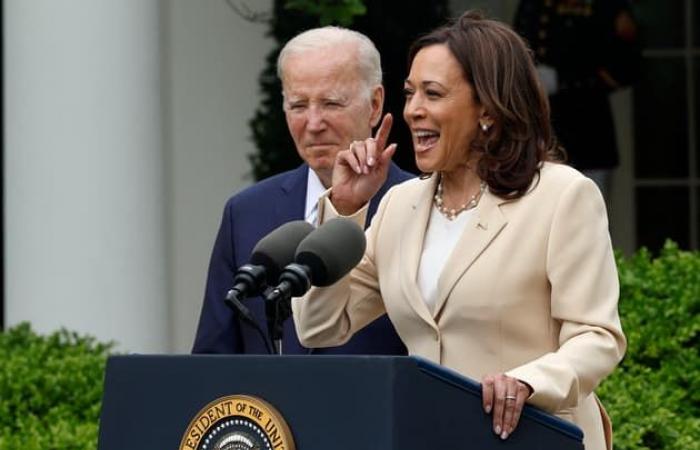From number 2 to number 1? By accepting the Democratic Party’s nomination this summer, Kamala Harris stepped out of the shadow of Joe Biden, whose vice president she was throughout his term. Having become the first woman and the first black person to hold the position in 2020, Kamala Harris faithfully supported the American head of state for four years.
So much so that for the Republican camp, she has become the accountant of Joe Biden’s record, which she will have to defend on the night of Tuesday 10 to Wednesday 11 September during a major debate against Donald Trump organised by ABC – and broadcast live on BFMTV. According to the Republican billionaire’s running mate, JD Vance, she was the one who “commanded” the White House in recent years.
“The border tsarina”?
On paper, the US Constitution provides no role for the vice president other than to preside over the Senate and replace the head of state when he is unable to act.
The rest of his duties “depend entirely on the goodwill of the president and the ability of the vice president to find openings to make himself useful without alienating the boss,” the New York Times summarizes.
Kamala Harris quickly saw the immigration file arrive on her desk. Joe Biden asked her to take up this hot topic in March 2021, when his administration was faced with a massive influx of migrants at the border with Mexico.
“It’s far from being a gift,” says Olivier Richomme, professor of American civilization at Lumière Lyon-2 University, interviewed by BFMTV.com. “Immigration is a red herring in American politics. No one really has a solution, and it’s been Donald Trump’s stock in trade since 2016.”
Harris’s early missteps on the issue have not failed to fuel criticism from Republicans. While traveling in Guatemala in June 2021, she found herself cornered by an NBC reporter asking why she had never been to the border in person. “And I haven’t been to Europe either. What are you getting at?” she tried to dodge, before the sequence became a hot topic in the conservative press.
That same day, she tried to dissuade Central American populations from embarking on a “dangerous journey to the U.S.-Mexico border.” “Don’t come, don’t come,” she told them firmly, this time drawing the wrath of the left wing of the Democratic Party.
At that time, the number of monthly arrivals at the border regularly exceeded 200,000 migrants, a figure that had not been reached since 2000. Republicans, led by Donald Trump, began to nickname Kamala Harris the “border czarina”, a way of making her responsible for the crisis.
A partnership for Central America
In reality, Harris was not actually in charge of border management, a task that falls more to Homeland Security Secretary Alejandro Mayorkas – also a target of Republicans.
“Kamala Harris’ role was more diplomatic,” notes Olivier Richomme. “She tried to improve the standard of living in the countries of departure so that people would no longer have reasons to emigrate to the United States.”
“Rather than signing blank checks to regimes undermined by corruption, Kamala Harris bet on the private sector to develop jobs in the region,” the researcher continues.
Some fifty companies, united within a Partnership for Central America, have thus invested some 5 billion dollars, allowing – according to the White House – the creation of 70,000 jobs in Guatemala, Honduras and El Salvador.
“It’s a good idea, but it will only bear fruit in the very long term,” says Olivier Richomme. In the meantime, migrants are still flocking to the border and Joe Biden has taken measures to try to stop them. Immigration reform is in the pipeline, but it is blocked in Congress by Republicans, under pressure from Donald Trump.
The decisive vote in the Senate
In addition to her travels on the theme of immigration, Kamala Harris has made numerous trips abroad to represent the American president. However, she has not led any major negotiations, whether for Ukraine or the Middle East. Unlike Joe Biden, who was very active on the international scene during his vice-presidency under Barack Obama.
More active on American soil, the former prosecutor has taken an interest in a whole range of social issues, ranging from early childhood to health, including access to voting for minorities. On this last subject, however, the bills she supported ran into opposition from Republican senators and were never adopted.
As shootings continue to plague America, Joe Biden also nominated her in 2023 to lead the White House Office on Gun Violence Prevention, which is tasked with enforcing gun laws. According to its deputy director to the New York Times, more than 400 gun stores have been closed for violating the rules.
As President of the Senate, Kamala Harris also played a decisive political role. In a chamber divided 50/50 between Democrats and Republicans, her vote helped tip the balance in favor of the presidential camp. According to a count by the New York Times, the vice president used her decisive vote (tie-breaking vote) 33 times, a record in American history.
While most of the votes were to confirm nominations, it also helped to pass theInflation reduction Acta gigantic plan of ecological and social reforms – and a flagship text of Joe Biden’s mandate.
The right to abortion, “a turning point in his vice-presidency”
Despite these numerous attributions, Kamala Harris remained discreet in the first part of her mandate, largely eclipsed by Joe Biden. Nothing surprising, according to Olivier Richomme.
“Apart from Dick Cheney under George W. Bush, all the vice-presidents have remained in the shadow of their president. It’s a thankless job,” says the US specialist.
In June 2022, the Supreme Court’s revocation of the federal right to abortion gave Kamala Harris a new lease of life. “It’s a turning point in her vice presidency. That’s where she really found her way,” says Olivier Richomme.
The Democrat is protesting against a decision that endangers the lives of many women, for whom she has become the spokesperson. “This is the first time in the history of our nation that a constitutional right has been taken away from the American people,” she denounces in a notable speech on the very day that the Roe v. Wade decision was overturned.
Her fight for women’s rights is not new. As a member of the California Attorney General’s Office, she had fought the deceptive practices of certain anti-abortion activists. And as a senator, she had been very critical of conservative Judge Brett Kavanaugh, bombarding him with questions during a confirmation hearing before his nomination to the Supreme Court.
Enough to stand out from Joe Biden, who has always been cautious on the subject. When he entered the Senate in 1973, he even considered that the Supreme Court had “gone too far” by ruling in favor of federal protection of the right to abortion.
“Kamala Harris is better placed to talk about abortion than an 80-year-old Catholic,” concedes Olivier Richomme.
Kamala Harris’s commitment appears to have resonated with voters. Since the Supreme Court ruling, conservatives have lost virtually every referendum or election that has addressed the issue of abortion, even in states that are traditionally largely conservative, such as Ohio, Alabama and Kansas.
The right to abortion is now at the heart of Kamala Harris’ campaign. Facing Donald Trump, the vice president is using it as a powerful argument to win precious votes among women and young people. Enough to go from the Naval Observatory, residence of the veepin the Oval Office? The trajectory is in any case far from unprecedented: a third of American presidents have been vice-presidents before reaching the highest office.
- BFMTV.com






